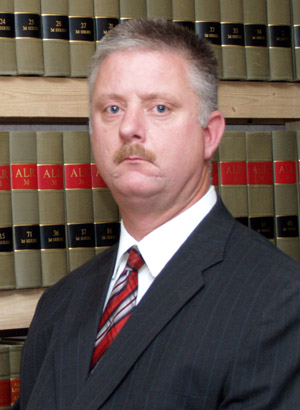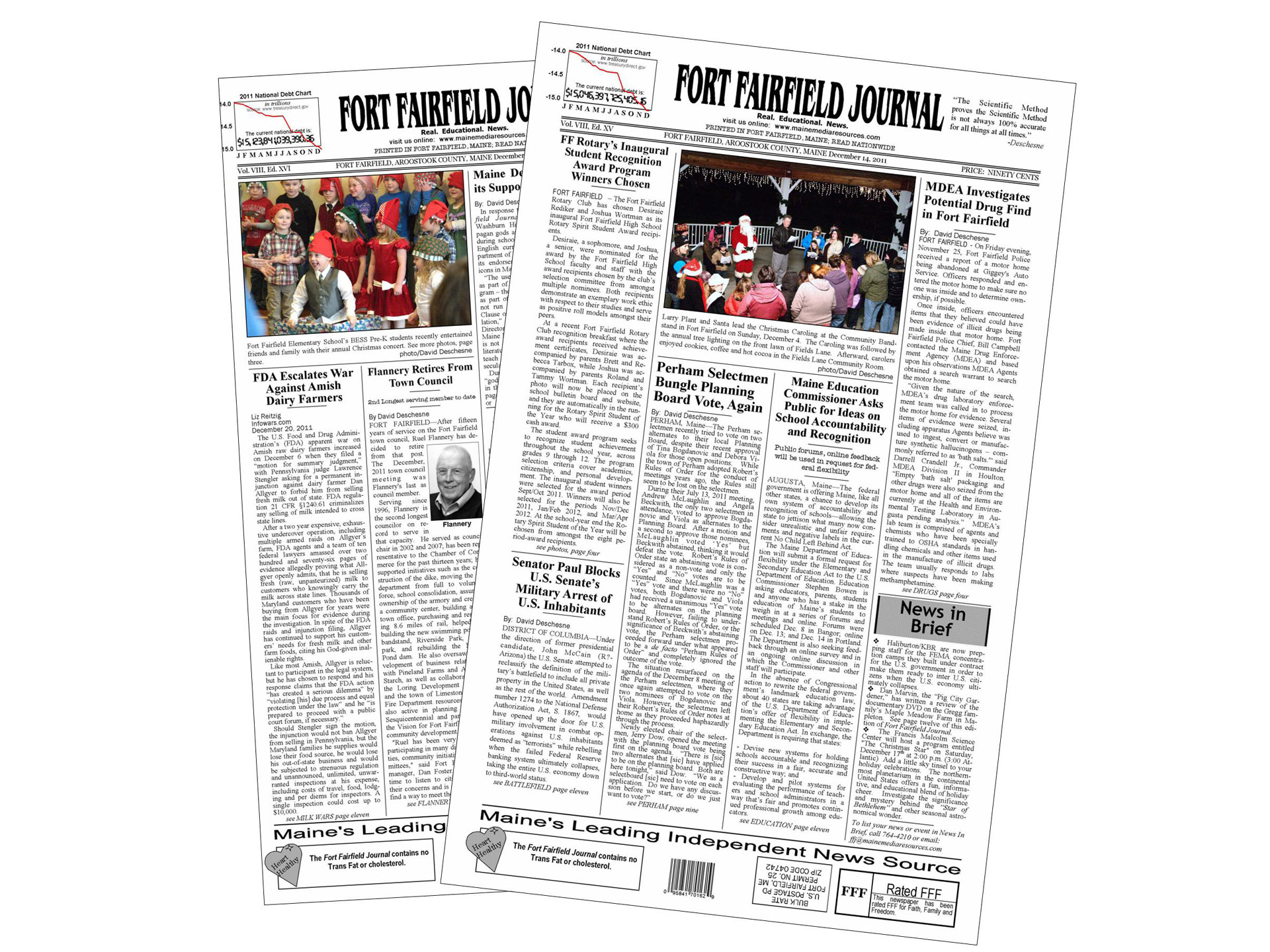

From the Editor

By: David Deschesne
Editor/Publisher,
Fort Fairfield Journal
August 23, 2023
It is becoming increasingly obvious that the carbon dioxide climate change green energy movement is just a grift to at once make a lot of money for a select few corporations while consolidating government power by reducing the available energy to the masses, ultimately quashing their ability to freely travel and limiting access to all the things that make modern life livable.
Over the past several years, many climatologists and ecologists have been coming forward to say out loud what the climate extremists don’t want to hear: that carbon dioxide is a minor greenhouse gas that doesn’t really contribute much to the overall climate events on earth; that the climate models have been rigged to predict a predetermined outcome; and grant money is rewarding only those scientists who ascribe to a climate disaster caused by carbon dioxide narrative.
In 2020, climate activist, Bjorn Lomborg published his book, False Alarm: How Climate Change Panic Costs Us Trillions, Hurts the Poor, and Fails to Fix the Planet (ISBN 978-1-5416-4747-3). The quotes I use in this editorial will be from that book, followed by the page number.
Lomborg is no Q-anon right wing conspiracist, as his detractors may try to label him. He is visiting professor at Copenhagen Business School and visiting fellow at the Hoover Institution at Stanford University. While I personally do not believe there is enough evidence to support the theory that carbon dioxide produced by burning fossil fuels is affecting the climate in any significant way (the Earth naturally vacillates between warming and cooling cycles despite the carbon dioxide levels, and has for millennia), Professor Lomborg does believe that.
He states, “Climate change is real, man-made, and something we need to fix. Yet, it is a problem, not the end of the world. That means stopping claiming that climate change is an ‘existential threat’ that could wipe out humanity. Panic is not the way forward.” (p. 231)
Lomborg continues supporting his position by admonishing, “The science shows us that fears of a climate apocalypse are unfounded. Global warming is real, but it is not the end of the world. It is a manageable problem. Yet, we now live in a world where almost half the population believes climate change will extinguish humanity. This has profoundly altered the political reality. It makes us double down on poor climate policies.” (p. 6)
Solar Energy
Currently, here in Maine, as well as around the country, there is an irrational push to shift the power grid over to solar energy.
However, solar energy is the least energy-dense energy source next to wind and only produces usable amounts of electricity for less than half the day when it’s fully sunny and even less than that when it’s overcast, snowing or raining. This means a backbone of more reliable grid electricity such as hydropower and fossil fuel-based generation capacity must be kept online to cover demand when the sun isn’t shining so people will still have access to electricity when they need it.
However, the politicians have been convinced that throwing millions of dollars of ratepayer subsidies at building Community Solar Farms is going to somehow stop the Earth from going through its cooling and warming cycles. It won’t. But, what those solar farms will do is make a few corporate owners filthy rich at the expense of the electricity consumers and in 20 years, that future generation of people will have to figure out what to do with those used-up solar panels since the cells themselves cannot be efficiently recycled. (Solar panels have a usable life of 20 years after which they begin to degrade and put out less power).
Lomborg points out that, “a solar panel, for instance, can provide electricity for a light at night and a cell phone charge, but it cannot deliver sufficient power for cleaner cooking to avoid indoor air pollution, a refrigerator to keep food fresh, or the machinery needed for agriculture and industry to lift people out of poverty (p. 12)...We should be innovating tomorrow’s technologies rather than erecting today’s inefficient wind turbines and solar panels. We should explore fusion, fission, water splitting, and more. (p. 14)...putting up inefficient solar panels makes for good photo ops, and it feels like we’re doing something—funding eggheads is harder to visualize. (p.15).
In his book, Lomborg tells the story of Dharnai, India where that small town was not connected to the country’s electric grid so they decided to build a solar farm to supply themselves with electricity. In 2014 Greenpeace supplied Dharnai with a solar-powered “micro grid” that was not connected to the national electric grid. “The day the electricity was turned on, the batteries were drained within a few hours,” writes Lomborg, “Because solar power is way too weak to power a stove, the citizens now had maybe a lamp illuminating the kitchen, but they still had to use the same old cook stoves burning wood or dung, polluting the home and putting the whole family at risk.” (p. 106)
The city soon figured out solar alone was not robust enough to provide electricity at grid scale and mass protests ensued. A week after the protests, Dharnai was hooked up to the national grid which was not only more reliable, it was available at one third the price of solar energy.
But, politicians in Maine continue to think those solar panel farms are going to fix everything. They’re living in an echo chamber where only the green energy solar gurus get a chance to speak. Out here in the real world, people already know solar panels, while they may be good for augmenting power or providing backup power for individual homes, are in no way robust enough for grid-scale use.
Carbon Dioxide is Plant Food
As the Earth’s atmosphere increased in carbon dioxide levels over the past few thousand years, the rate of plant growth also increased. This is because all green plants use carbon dioxide as a food source, using sunlight to convert the carbon into sugar molecules and giving off oxygen as a waste product which all animal life forms use to breathe!
Increased levels of carbon dioxide also help plants to resist droughts and dry weather because they don’t need to grow as many of the pores needed to collect carbon dioxide from the air and thus lose less internal water through evaporation.
Over the past 100 years of steadily increasing carbon dioxide levels, the Earth has actually become greener.
Lomborg explains further, “...something started happening in the 1970s: mostly because of global warming, we started getting more green vegetation. And this will continue over the century as we continue to emit more fertilizing carbon dioxide. Indeed, if we follow a standard worst-case scenario for carbon dioxide emissions to the end of the century, we could end up with almost 50 percent more green mass in the world by 2100. By one estimate we would be above the amount of green the world had in 1500, before we started the widespread reduction in global vegetation.” (p. 57).
But the Polar Bears!
One of the classic images climate alarmists use is the picture of a polar bear floating on a small piece of ice off into the sunset and perhaps his ultimate demise (surprise, polar bears are great swimmers!) The implication is the Earth is warming, all the ice is going away and the polar bears are all going to die.
While it is true some ice is melting due to the Earth’s natural warming cycle, and the polar bear population was in decline at the same time, Lomborg mentions how wildlife biologists looked into it and found out the decline in polar bear populations was due to over-hunting them by man, not because the ice was melting. As soon as legislation was passed to limit hunting polar bears, their numbers steadily increased over the years. Needless to say, the poor downtrodden polar bear is no longer a poster boy for Climate Change! (ref. pp. 50-52)
But the Hurricane and Flood Damage!
Climate alarmists point to the increasing devastation of hurricanes and floods to homes and businesses and conclude it’s because the storms are getting more severe due to climate change. But, not so fast! Lomborg describes something called the “expanding bull’s-eye” effect where towns which were initially built in flood and hurricane high risk zones a hundred years ago suffered comparatively little damage from floods and hurricanes but subsequently increased in population and the number of homes and businesses spread out over an increasingly larger area in those dangerous zones. Add to that the increased cost of modern buildings, there will naturally be more destruction and higher cost simply because there are more buildings in harm’s way—not that the storms are any more severe, which they are not. (ref. pp. 35-37)
But the Heat Waves!
The media loves to point to heat waves and blame them on global warming caused by carbon dioxide. However, Lomborg points out an inconvenient truth that cold weather actually kills more people annually than hot weather. He cited a study in the medical journal, Lancet which showed one hundred forty thousand people die from heat each year but more then two million die from the cold. Heat deaths are less because the heat waves are intermittent and people can find ways to get into shade or cooler areas during the day and overnight the heat subsides. Meanwhile, cold temperatures are persistent and can last for weeks. As a human body succumbs to the cold over the days and weeks, the blood vessels near the skin constrict in order to preserve heat but that raises the body’s blood pressure and increases the chance for heart attack and stroke. We hear more in the media about deaths from heat because they are easier to observe and report on but Lomborg says, “we do not hear about the thousands of slower cold deaths; this is because there are no TV cameras when most elderly, weak individuals expire over weeks or months in anonymous apartments.” (p. 53)
Electric Cars Not the Solution
Maine is currently on track to follow California’s model by outlawing the sale of most gasoline and diesel powered automobiles and trucks by the early 2030s and forcing everyone to buy an expensive electric vehicle. But, electric vehicles are not carbon neutral. After all of the mining of minerals and metals, transportation, refining and production and delivery –then charging with electricity derived by fossil fuel generators are factored in, a typical electric car will emit 26 tons of carbon dioxide over its lifetime. Compare that to a gasoline powered car that will emit around 34 tons over its lifetime and we find electric vehicles don’t eliminate emissions. Rather, they cut them by 24 percent, leaving more than 75 percent of those emissions in place. (ref: p. 95)
Green: High Cost, Low Benefit
Lomborg goes into intricate detail of the economics of reducing carbon dioxide in his book. There is way too much to go into here but suffice it to say that the more measures are put in place to presumably lower the Earth’s global temperature, the more it will cost society and the poorer it will make people. When people are poor, they cannot afford to eat healthy foods, or any food at all, have less access to heating and cooling of their homes, less access to transportation to and from a job, less access to health care and less ability to improve their home and living conditions. Thus, making people poorer puts their health in greater danger than carbon dioxide does.
Solutions
Lomborg suggests more money should be put into research and development rather than just dumping it into inefficient solar panels and wind turbines. He is also an advocate for clean, safe nuclear energy.
Overall, while I don’t agree with everything in his book (like his call for a global carbon tax on everyone), I think there’s enough in there that warrants further discussion. I highly recommend this book for anyone who wants to seriously understand the real impacts of climate change and the negative impacts of the Green Energy solutions politicians are haphazardly and irresponsibly forcing us into at the present time.

This online version of Fort Fairfield Journal is an abridged version of the hard copy, print edition which is sold in stores throughout central and southern Aroostook County, Maine and via mailed subscription. Purchase a copy or subscribe to get all the news not archived on this website. The hard copy, print edition of the Fort Fairfield Journal is a research paper dedicated to bypassing corporate and social media censorship.
WFFJ-TV
Fort Fairfield Journal Television produces news and documentary videos. View them on our censorship-free Rumble channel.
Link to WFFJ-TV's Rumble Channel >>
© 2023 David R. Deschesne
Fort Fairfield Journal
P.O. Box 247
Fort Fairfield, Maine 04742
(207) 472-0667
editor@fortfairfieldjournal.com